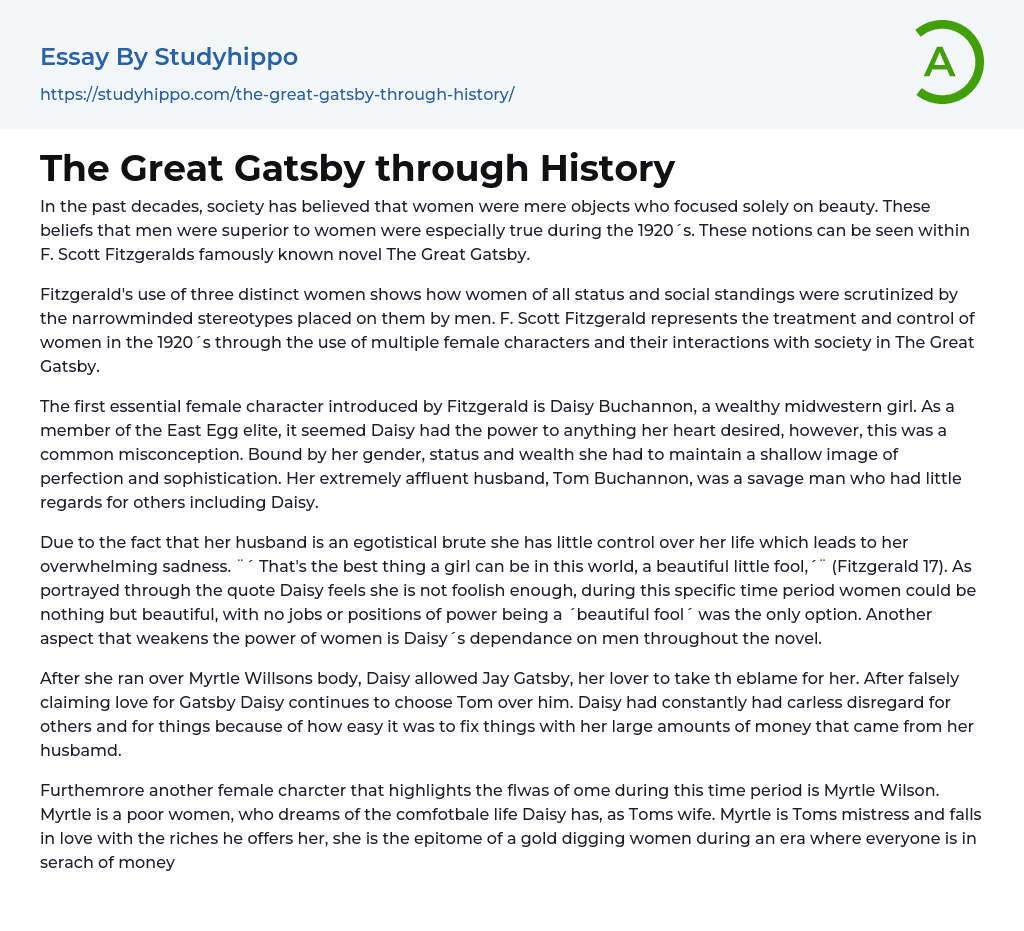In the 1920s, society widely viewed women as objects focused solely on their appearance. This perception of male superiority over women has persisted for decades and is evident in F.
In his renowned novel The Great Gatsby, Fitzgerald explores the depiction of women and the stereotypes placed upon them by men. By showcasing the interactions between various female characters, Fitzgerald emphasizes the treatment and dominance of women during the 1920s. One prominent character exemplifying this is Daisy Buchanan, a wealthy woman hailing from the Midwest who resides in the affluent East Egg community. Though she possesses apparent influence and advantages, Daisy's capabilities and aspirations were frequently misconstrued.
Constrained by her gender, social status, and wealth, she was obligated to uphold a superficial facade of flawlessness and refinement. Her husband, Tom Buchannon, an excessiv
...ely affluent man, was a cruel individual who harbored little regard for others, including his wife Daisy. Given that her husband epitomizes an egotistical brute, Daisy has limited influence over her own life, resulting in profound sadness. "That's the best thing a girl can be in this world, a beautiful little fool," (Fitzgerald 17).
The quote depicts Daisy's sentiment that she, during this era, feels she lacks the level of foolishness expected of women. In this specific time period, women were limited to being nothing more than beautiful adornments, with no opportunities for employment or positions of authority. Being a "beautiful fool" was the only viable role they had. Another factor undermining women's power is Daisy's reliance on men throughout the novel. When she accidentally hit Myrtle Willson with her car, she allowed her lover Jay Gatsby to take the blame. Despite professing love for Gatsby,
she continuously chooses Tom over him. Daisy consistently exhibits a careless disregard for others and possessions due to her ability to easily rectify any problems with her significant wealth acquired through her husband.
Another female character who also highlights the flaws of women during this time period is Myrtle Wilson. Myrtle, a poor woman, dreams of having the comfortable life that Daisy enjoys as Tom's wife. Myrtle becomes Tom's mistress and falls in love with the wealth he provides, embodying the stereotype of a gold-digger during an era where everyone is in pursuit of money.
- 1984 essays
- A Farewell to Arms essays
- A Good Man Is Hard to Find essays
- A Hanging essays
- A Lesson Before Dying essays
- A Long Way Gone essays
- A Rose For Emily essays
- A Separate Peace essays
- A Tale Of Two Cities essays
- A Very Old Man With Enormous Wings essays
- Adventures Of Huckleberry Finn essays
- Alice in Wonderland essays
- All Quiet on The Western Front essays
- Allegory of the Cave essays
- An occurrence at owl creek bridge essays
- Animal Farm essays
- Anthem essays
- Antigone essays
- Arthur Conan Doyle essays
- As I Lay Dying essays
- Atticus Finch essays
- Barn Burning essays
- Battle Royal essays
- Beauty and The Beast essays
- Beloved essays
- Boo Radley essays
- Brave New World essays
- Candide essays
- Castle essays
- Characters In Hamlet essays
- Characters In Romeo And Juliet essays
- Christmas carol essays
- Chronicle of a Death Foretold essays
- Cinderella essays
- Crime and Punishment essays
- Daisy Miller essays
- Death of a Salesman American Dream essays
- Desdemona essays
- Diary Of A Wimpy Kid essays
- Dracula essays
- Dubliners essays
- Emma essays
- Ender'S Game essays
- Ethan Frome essays
- Eveline essays
- Fahrenheit 451 essays
- First-Person Narrative essays
- Fish Cheeks essays
- Frankenstein essays
- Genesis essays




